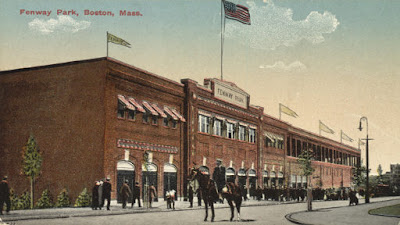Alfredo Carl "Stats" Pagano is a 12-year-old Red Sox fan whose father has operated a hot dog stand outside Fenway Park for years. When the 2012 Red Sox start losing games left and right, putting their season in jeopardy, Stats wonders if his favourite team may once again be cursed.
Lefty pitcher Billee Orbitt, slumping in his sophomore season after a spectacular debut, has been having similar thoughts. Orbitt, nicknamed the "Spacebird", is a regular customer at Pops's Red Sox Red Hots and he enlists Stats to crunch some numbers and ask around Fenway to see if anything odd is going on.
What Stats discovers takes in (and ties together) electromagnetic fields, ley lines, the summer solstice, the Great Pyramid at Giza, the Chinese concept of chi, and the hawks that call 100-year-old Fenway Park home.
Fenway Fever (Philomel/Penguin) is by
John H. Ritter, who has written five other baseball-themed books for the 10-14 age group, including
Choosing Up Sides,
Under the Baseball Moon, and
The Desperado Who Stole Baseball. Although tagged as a "baseball novelist", Ritter's books have also taken a progressive look at segregation and racism in American society (and for much of baseball's history), the Vietnam war and the US's various invasions of Iraq, and religious bigotry.
The curse plotline in the new book is a weak premise (and I'm sure some Cubs fans would take exception to the description of the Red Sox's pre-2004 title drought as "baseball's longest running bad luck streak"). Who would think that a frustrating losing streak in late May/early June of one season would equal a new curse? A 10-game skid ain't
nothin' compared to what Red Sox fans went through before 2004 (or in September 2011, for that matter); Terry Francona's debut season as manager may be well before Stats's time as a fan, but ol' Pops Pagano could set his son straight. The idea that something is amiss in the Fens because the Red Sox have not come close to winning a World Series since 2007 is a bit much for this grizzled veteran.
But, anyway, two-thirds of the way through the book, the curse talk takes a back seat as Ritter's narrative soars and becomes a heartfelt love poem to Fenway Park. At midnight before the summer solstice, Stats and Billee sneak into the old yard (and onto its roof) with a plan to restore balance (and winning).
Stats took a moment to gaze out across the Boston skyline, eerily unhindered by the ballpark lights.
But nothing he saw in any direction - the new Hancock Tower, the Prudential Tower, and the R2-D2 building on Huntington Avenue - compared, in beauty or grace, with the architecture of the building he stood upon.
Which was as it should be, as far as Stats was concerned, for no occupation practiced within any of those landmark structures could compare in skill or complexity or worth to the high artwork of those men who had declared somewhere in their olympian boyhoods the intention to dedicate their lives to mastering a child's game. . . .
Stats felt nothing beyond an elevated calm. And then he realized why. Fenway Park had always been a part of his heart. ...
Unless a kid had grown up right outside these brick walls, unless he had been guided through the high holy gates at an early age, down the green serpentine walkways to the narrow weathered-gray wood-slat seats Stats could still recall from his first-ever baseball game, he could not hold in his heart the pulsings of this hundred-year-old park the way Stats could.
Obviously, a kid might come close. Why? Because every clumpy crabgrass ballfield in every small town across the land, with its foot-carved riverine base paths, its dented-metal Coca-Cola scoreboard, its rock-clay pitcher's mound, had a bit of Fenway in it. Every dusty city dugout made of concrete blocks with splintered wood benches was made from particles of Fenway. Every empty city sandlot, every playground ballfield Stats had walked past in all of his long short years held a bit of Fenway, in the same way every teardrop holds a part of the sea.
That's because Fenway was more than an exact place. It was the love of baseball itself. . . .
While David Ortiz, Pedro Martinez, and Kevin Youkilis are mentioned in relation to the heroics of 2004 and 2007, the players on Ritter's 2012 roster are fictional. They do, however, have some oddly familiar names: pitchers Cedro Marichal and True Denton, catcher Burlin Fiske, first baseman Sandiego Gunsalvo, second baseman Dusty Doretta, outfielder Drew Evans, and pinch-runner Robertos David.
(In the book, Ritter alludes to a 2008 incident at Fenway when a hawk dive-bombed a young girl touring the park as part of a school field trip. Ritter does not mention the girl's name, but it would fit right alongside this bunch of Boston players:
Alexa Rodriguez!)
Fenway Fever is enjoyable, but light-hearted. I'd recommend
Under The Baseball Moon or
Over The Wall if you want to sample Ritter's more mature work.




















